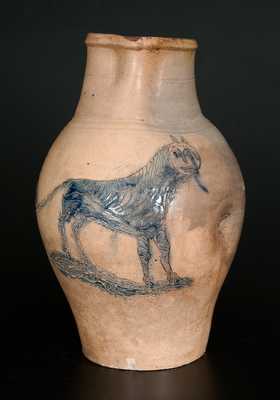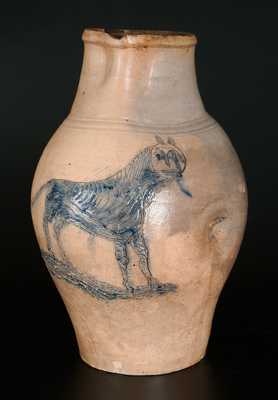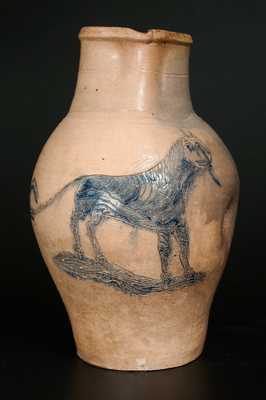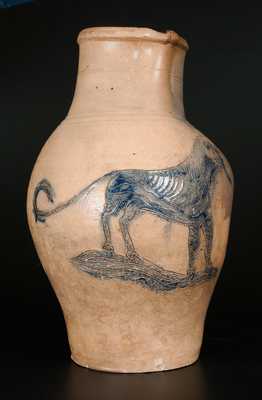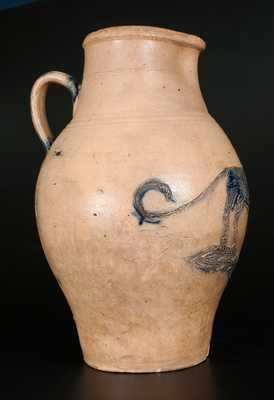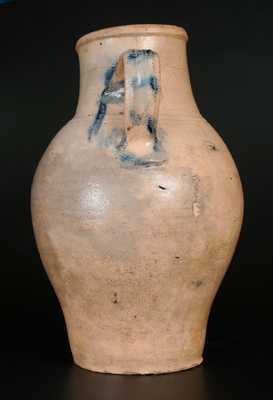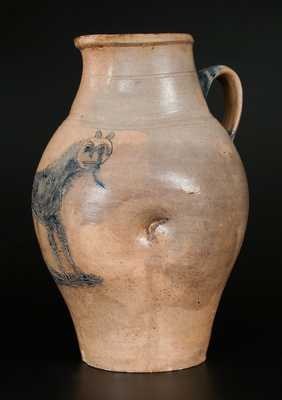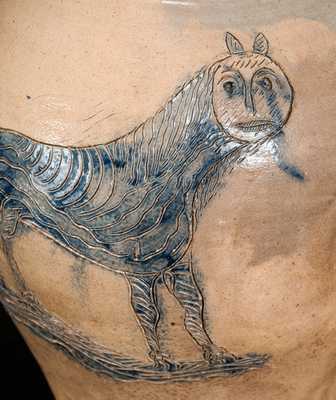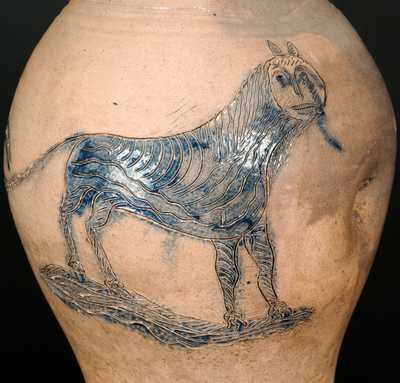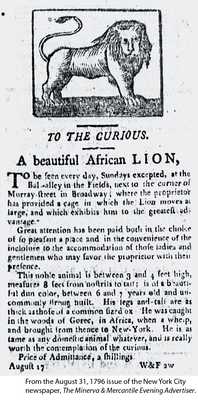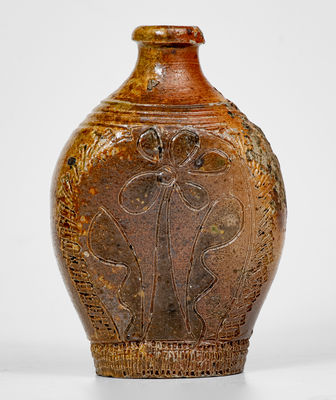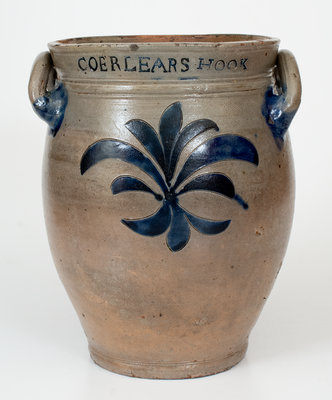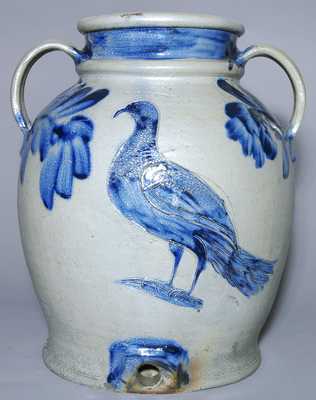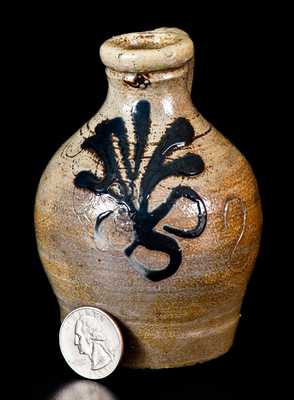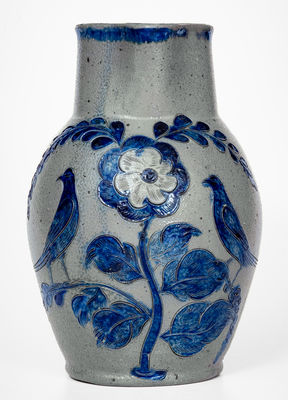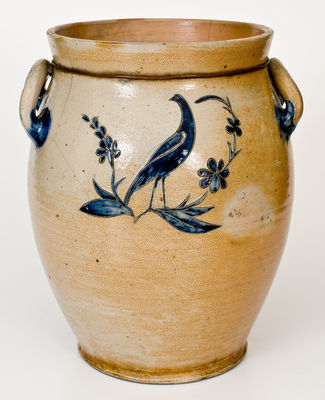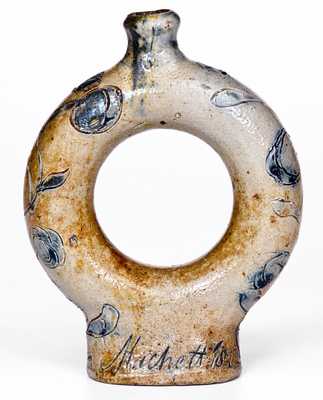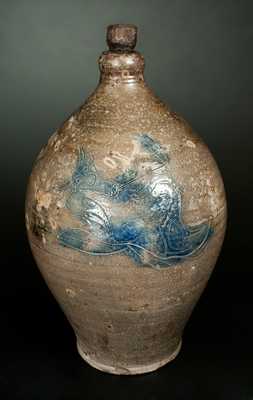Important and Possibly Unique Large-Sized Stoneware Pitcher with Incised Decoration of a Standing Lion, Manhattan, NY origin, possibly Crolius family, second half 18th century or early 19th century, two-gallon ovoid pitcher with heavily-tooled shoulder, narrow, tapering collar, and semi-rounded rim molding. Front of pitcher decorated with a large, deeply-incised design of a standing lion atop a stylized ground, filled with cobalt slip. Lion features a highly-unusual head-on stare with anthropomorphic face, bared teeth, and deeply-carved eyes. The figure is further embellished with a flowing mane, incised claws, and folky striped incising to the body, legs and long curling tail. From head-to-tail the lion measures an impressive 9" long. Handle decorated with brushed cobalt stripes and circles around the terminals. This significant recent discovery in early American stoneware is one of two pieces with incised lion decoration produced in Manhattan that we are aware of. The second example is a jar in the collection of Yale University, donated by John Paul Remensnyder in 1977. Few finely-incised pitchers from Manhattan are known to exist. This is the only example of the form we have seen with a figural motif other than a bird. The rare and visually-striking frontal view of the lion's face bears a striking similarity to incised owl or "catbird" decorations found on stoneware from the Northeastern U.S., in which the bird assumes a decidely human visage. Other printed images of animals from the 18th and 19th centuries depict animals with human-like faces, and it seems that this overall style may have been prevalent during the time period. The use of a lion decoration in early America is an interesting one, given the fact that the animal was a traditional symbol of Great Britain. This fact is likely one reason why this design is rarely found on early American stoneware, and why the Federal eagle was naturally so popular. As more and more understanding emerges, early stoneware from the Northeast continues to be pushed by scholars to earlier production periods. While ten years ago, dating a piece to the 1750-1775 time range might be a daunting task, it is now done with more regularity. This updated dating of stoneware offers the possibility that this pitcher may have been made prior to 1776, when America was still under British rule. Another very probable origin for this particular design is the popularity of animal shows and circuses during the period. Various traveling shows during the 18th and 19th centuries displayed rare exotic animals, which were considered great curiosities of their day. In many cases, the viewer had never seen the animal before, outside of prints and drawings. One specific lion was on display in several cities from at least 1791 to 1797, and was advertised over and over again in various American city papers, becoming something of a national celebrity. The August 31, 1796 issue of the New York City newspaper, The Minerva & Mercantile Evening Advertiser, referring to this lion, advertised, "To The Curious. A Beautiful AFRICAN Lion. To be seen everyday, Sundays excepted, ... in the Fields, next to the corner of Murray street in Broadway, where the proprietor has provided a cage in which the Lion moves at large ... ." It may have been the viewing of a creature at such an event that inspired the decoration on this pitcher, and the similarity of the woodcut that ran with the aforementioned ad to the design on this pitcher may be more than a coincidence. Certainly one of the most important discoveries in Manhattan stoneware of the past decade. Provenance: A fresh-to-the-market example, which descended in a Brooklyn, NY family. Typical shallow, mostly small, chips to base. In-the-firing iron ping to reverse. Long shallow chip to left side of spout, either extremely old or an in-the-firing flaw. A second old chip to interior of rim on reverse. In-the-firing recessed spot on right side of pitcher. H 14".

